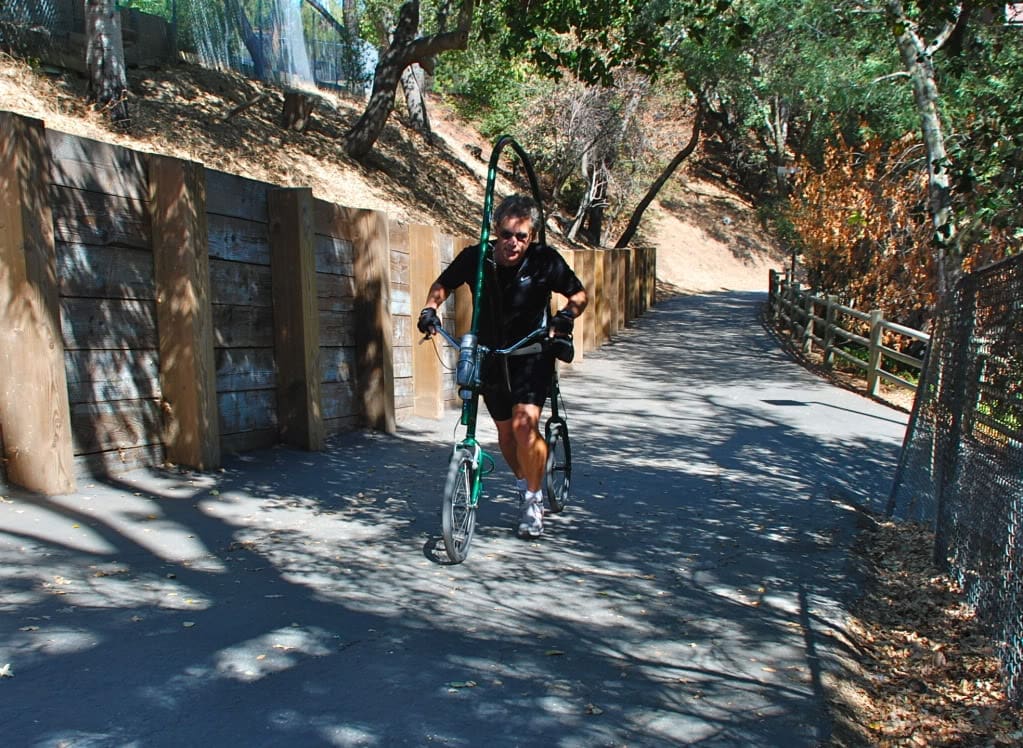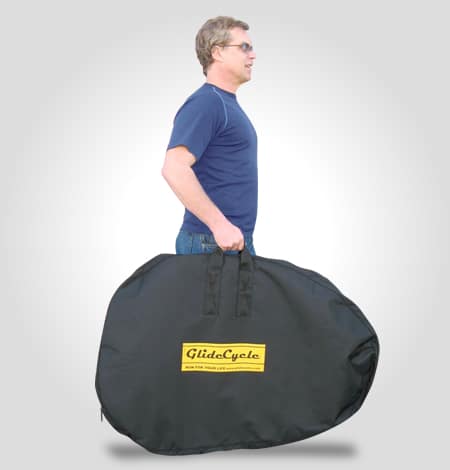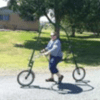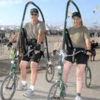What is the GlideCycle used for?
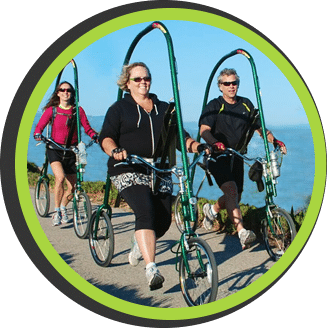
The GlideCycle™ is used as a sport and fitness training and injury prevention tool in the sports world; as an fitness and weightloss tool for baby-boomers and seniors with worn out joints, arthritis, and other age related difficulties; and as an amazing mobility walking or running cycle for folks with neurologic or orthopedic disabilities.
Is GlideCycle running for me?
Whether you are new to running or are a veteran runner, or just need to move, the GlideCycle is for you. Super athletes find GlideCycle running an incredibly efficient workout. Power up to vo2 max in intervals or go for 20 or 30 mile cardio marathons back to back without pain. It is also a great recovery day trainer, cross trainer or recreational sport in its own right. No matter how tough you are, the glider’s got you covered.
If you have given up running because of age, weight, injury or your legs just won’t keep up with as fast as you want to go, the GlideCycle will help you get that exhilarating feeling back like when you were at your best. You will walk, glide/run faster than ever, and a lot further and more often too! You will not incur further damage from running impact, yet you still feel like you are running.
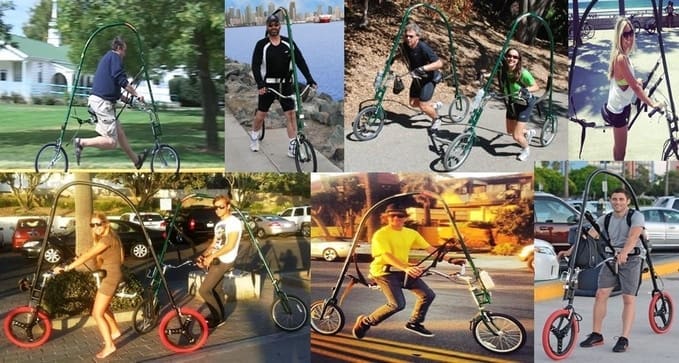

A GlideCycle explosively enhances the running ability of any user at any level of fitness, age, weight or ability.
- If you have stopped running or walking because of joint pain, injury or just because you think jogging is too hard on you
- For neurological rehabilitation and mobility training
- Virtually anyone wanting to run more often, run faster, really far or just run all day long without the usual post-exercise pain
- X-Runners of any age who want to "feel" the exhilaration of running again, get outside on the trail again or run/commute to work daily
- Anyone seeking weight loss, fitness, exploring new places with pain-free recreational touring/running for hours
- Runners and cyclists: for effective cross training, injury recovery and working hams, glutes and the core like nothing else can
- People who don’t like bike riding because of balance risk and high speeds....GlideCycle's have two wheels/two feet stability and are slow compared to bicycles at equal heart rates

Problem: Gravity Over 50 million Americans go running each year and 116 million more folks walk outdoors for fitness. Each year up to 70% of these runners will experience an injury needing rehabilitation. 1.5 million of them and countless walkers will quit and head for the gym or the couch for good. Gravity is the root cause, as so many runners and walkers simply can’t bear the pounding of 2.4 times their weight in ground reaction force. (BYU Study)
Solution: Weightless Running Revolution A Brigham Young University sports research study found that, “runners using the GlideCycle experienced an 86% reduction in ground reaction force (GRF).” Our patented suspension system lifts the body by cradling the pelvis (no crotch pressure) into the natural spring arch frame and allows clients to achieve a closer motion to actual running or walking than any other equipment on earth. Running with wheels means running fast, far, and as hard as you want without impact pain.
What is so important about reducing types of impact and cumulative impact?
Running and sports that require quick or jarring movement can be hard on the body. When running at high speeds, each foot plant can jar the body with a force up to twice the runner’s actual weight. Over time, with continued impact from these activities, it can begin to breakdown joints, bones, and muscles. These activities increase the risk of impact-related injuries such as stress fractures. If you can reduce impact, you can train longer and faster without the additional risk of impact-related injuries. The GlideCycle is the best alternative to running ever designed.
 Is the GlideCycle easy to ride?
Is the GlideCycle easy to ride?
People are amazed at how easy the GlideCycle is to use. Simply step into the GlideCycle, adjust the seat to your body and ride away.
It takes 20 minutes to learn the basics, 20 miles to master techniques and tame the saddle, and 100 miles to build the new muscle groups (hams and glutes) to really power up the workout to the max. The GlideCycle is really similar to a bike when going downhill…put your feet up and coast but keep it under 25 mph for safety.
Do I need to be Super Fit to Run or walk with My GlideCycle?
If you’re worried about your fitness level, be patient and take your time. While your body will respond quickly and adapt to training on the GlideCycle, people new to running or coming back to running may find it very physically demanding at first. We suggest that you begin your training in a parking lot or a big flat open area somewhere with little or no traffic. As with any new physical activity, if you initially find the going too tough, you should plan to periodically stop and rest to recover.
Practice will make the seat comfortable while holding your entire body weight between steps. GlideCycle distance runners easily run 1 to 4 hour plus sessions every day without pain! Everyone who has tried the GlideCycle is surprised by how powerful the workout is with little perceived effort.
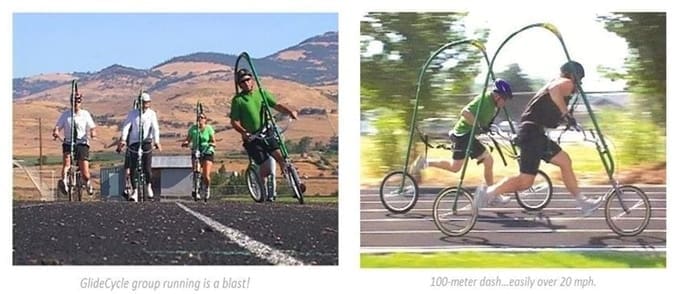 I’m a tall person (or a small person), will the GlideCycle work for me?
I’m a tall person (or a small person), will the GlideCycle work for me?
There are three GlideCycle models to accommodate user height. The smallest user can be 4’2” while the largest user can be up to 6’6” and each size overlaps. Children under 10 just need to grow up. But we are designing a unit for the Gliderboys and GliderGirls out there who want to run with parents!
Is it hard to balance?
It is easy. You have two feet and two wheels. When running with your feet on the ground you are not “balancing” on two wheels like a bike. You have two wheel and two feet stability. It is hard to fall over. When coasting with feet up on the footrest, you need the balance of any bicycle. And of course, you can get hurt if you close your eyes and find something large or small to stop you. You may feel awkward the first time you ride (like you did on a bicycle), however if you feel yourself leaning to one side, your feet are always there to support you!
NOTE: For individuals who would like an occasional assist, as us about our electric motor option…wow.
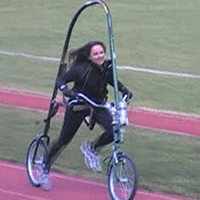 How fast can I go on the GlideCycle?
How fast can I go on the GlideCycle?
The GlideCycle speed varies on your fitness level. Speeds of 8 to 12 mph or 5 min. to 8 min. miles are to be expected for most athletic over as much as a 30 mile course!
Walk as slow as you like, even up a mountain. You never have to get off like on a bike as it is always easy to move when there are no pedals. If you like the wind in your face and seeing the world glide by, you will like the speed and pace of the GlideCycle.
How is the GlideCycle controlled?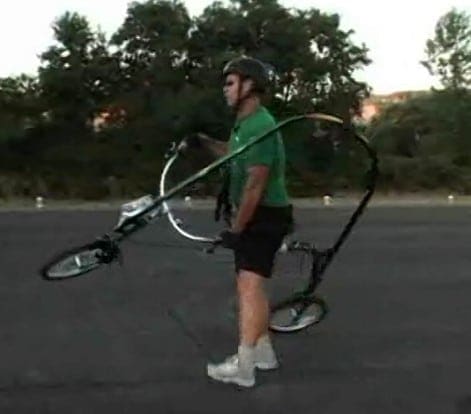
Steer the GlideCycle just like a bicycle and use standard hand brakes. It’s steering is prevented from over correction by an innovative turn limiter. The GlideCycle can actually be spun around in a circle as if standing on a paint can…fantastic for tightest turns.
Is the GlideCycle comfortable to ride?
Yes, it really is! The GlideCycle patented seat wholly suspends you by your pelvic region without any pressure at all on the crotch. Yet it allows free running motion of your legs with your feet on the ground. There are many adjustments in the seat to accommodate each individual’s unique body type and preferences. As you continue to ride your body will adapt and you will learn how to make subtle adjustments that will improve your comfort and ability to do longer rides. An experienced rider can set up a new seat in less than one minute. A good pair of padded bike shorts is advised for rides over 20 minutes just as for a longer bicycle ride. Riders can spend hours in the saddle…just like on a bike.
 What kind of terrain is suitable for the GlideCycle?
What kind of terrain is suitable for the GlideCycle?
Please note that you should always use common sense while gliding/running as with any sportive cycle. It is designed for adults riding on paved surfaces, smooth gravel, or improved trails, where tires are not intended to leave the ground. Experienced riders can run on beaches, or mountain bike trails once aware of special techniques required: like no bunny hopping, but lifting the front wheel sideways going over bumps bigger than 3 to 4 inches. Your GlideCycle™ is not designed for performing stunts-- except for running sideways on walls.
Is the GlideCycle hard to steer?
Steering the GlideCycle will feel different at first. Most people adapt after a few minutes of riding. Some require a little more time (10 to 20 minutes in two sessions). Almost everyone masters it by the 2nd or 3rd riding experience. Comparatively, it is much easier than learning to steer a bicycle for the first time. The GlideCycle is fitted with front and rear brakes exactly like a bike. It is best to use front and rear brakes together when slowing down or coming to a stop.
Any modern bicycle has a gear shift or transmission of 3, 5, 10, 15 or even 20 gears. Your GlideCycle Saddle Assembly can “shift gears” as well by tilting the pelvic pad forward to go up hills, backwards to comfortable coast down hills and hold vertical (cruise position), in effect acting as your transmission to control momentum over rising and falling terrain. The basic idea is to keep your body in line with gravity. There are shifting buckles on the webbing for adjusting your body position to climb hills easily.
Can you ride the GlideCycle uphill or up a really long, steep mountain climb?
Yes you can! When the rider shifts the saddle into the climb position. You will be slower than a bike — sometimes a crawl, depending on your fitness level. But, nothing stops a GlideCycle.
Going uphill does require proper technique, a little practice and like any exercise, more effort for hills (gravity is never free). The basic approach for short hills is to lean forward in the seat, while extending your legs back and pushing off with your toes in a driving motion. For longer hills loosen the lower front strap completely allowing you to rock forward in the seat and resting your chest on the front strap. Your arms also help to support your weight. In this position you can climb longer hills. If your fitness level is really low, you can always simply stand up in the seat and walk up the hill. With a little practice and as you get into shape you can go anywhere you want. Athletic riders will find it possible to glide up any mountain. Even climb the Rocky Mountains, for miles and miles and monster workouts.
Is it easy to transport?
The GlideCycle is designed for 1 to 3 minute break down or assembly. It easily slips apart in 5 pieces plus the saddle seat. Lay the frame pieces into the GlideCycle custom carry bag, zip the case and you are ready to take your GlideCycle anywhere. At 31 lbs. without the seat and 36 lbs. with the seat, it is light enough to carry on your back or walk to the trunk or back seat of an average compact sedan or hatchback.
Would my heart rate be different when using the GlideCycle? Will I be able to use heart rate to judge my workload?
Yes, you’ll be able to use heart rate to judge your workload. If you’re walking fast or running with the GlideCycle, your heart rate will indicate your workload just as it does with other forms of exercise. To receive a more intense cardio-vascular workout, you can increase your speed to reach a higher heart rate and caloric burn. Heart rate can be used to determine the speed you need to go to achieve the same cardiovascular workout that you’d achieve with unassisted running. In short, you can do the same amount of work (cardiovascular intensity) by just running a little faster, but the impact on your body will be reduced significantly. And Glide/Runners go for hours every day unlike runners.
What is so important about reducing types of impact and cumulative impact?
Running and sports that require quick or jarring movement can be hard on the body. When running at high speeds, each foot plant can jar the body with a force up to 2.5 times the runner’s actual weight. Over time, with continued impact from these activities, it can begin to breakdown joints, bones, and muscles. These activities increase the risk of impact-related injuries such as stress fractures. Internal organs and even skin feels the effects of gravity tugs. If you can reduce impact, you can train longer and faster without the additional risk of impact-related injuries and aging. The GlideCycle is the best alternative to running ever designed. It still feels like running, but like running on the moon...
Will I still get sore muscles?
Like any form of exercise, you will get sore muscles if you don’t follow a recovery plan after each session. Muscle soreness is a result of the micro-tears that occur when your muscles are stressed during training. Your recovery plan should include adequate hydration during and after training. A drink like Gatorade to replenish electrolytes and an energy protein snack with a 4:1 carbohydrate to protein ratio, consumed within 30 minutes after training can really help. With continued training, muscle soreness becomes less and less, your waist gets smaller, your muscles get chiseled, and you smile more. Although little post-exercise pain follows, hair tends to stay messed up for some time.

I have difficulty exercising to lose weight because of physical limitations due to being overweight, can the GlideCycle help?
Yes, the GlideCycle allows individuals to reduce their body weight while providing cardio/aerobic, core and leg muscle exercise simultaneously. However, weight loss and control is highly dependent on balancing the number of calories taken in by the number of calories burned. A healthy diet is key—and regular exercise is vital. GlideCycle takes exercise outside and makes it FUN! And that means MOTIVATION.
What is the maximum amount someone can weigh to use the GlideCycle?
The GlideCycle standard supports folks up to 230lbs. Our large size, the GlideDale is rated for up to a 330 pound individual.
My doctor has suggested that I do more aerobic conditioning, but high-impact activities are not an option for my knees, hips, and back. Can the GlideCycle™ help me get the aerobic exercise I need?
Absolutely. the GlideCycle's™ unweighting equipment allows individuals to reduce their body weight as much as 86% (BYU study). This means you can exercise and achieve the aerobic conditioning you need, without the full force of impact on your knees, hips, and back. It is the best outdoor cross trainer for runners and cyclists to be found.
I just had knee surgery (or hip replacement, Achilles injury, stress fracture, or other lower extremity injury or surgery); can the GlideCycle help me during rehabilitation?
The GlideCycle is a great tool for training through common injuries or to add to a rehabilitation program after a lower extremity injury or surgery. Of course, you should always consult with your physician or physical therapist, but elite training centers around the world are prescribing expensive body unweighting equipment specifically for these applications.
Many lower extremity rehabilitation programs stress the importance of becoming mobile as soon as possible after injury or surgery. Non-impact, partial weight bearing exercise is a natural choice for patients to move early through the pain free range of motion preventing scar tissue and washing the area with increased oxygenated blood flow keeping down inflammatory tissue. It allows for movement without the resistance of water, or restrictions of a harness, it is becoming a preferred unweighting system… because it’s fun and that means compliance.
My doctor has suggested that I do more aerobic conditioning, but high-impact activities are not an option for my knees, hips and back. Can the GlideCycle help me get the aerobic exercise I need?
Absolutely! The GlideCycle unweighted bicycle allows individuals to lift their body weight as much as 86% (Brigham Young University study). That means you control the impact from little to a lot as you wish. This means you can exercise and achieve the aerobic conditioning you need in whatever condition you find yourself on any given day. Training without the full force of impact on your knees, hips and back allows for more training sooner.
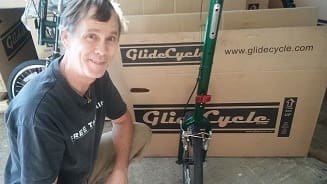 What kind of maintenance is required and is there a waranty?
What kind of maintenance is required and is there a waranty?
Very little maintenance is needed. Keep your GlideCycle clean as you would your bicycle. Lubricate joint tubes to slip apart well. Keep away rust on chrome and a simple rub down with Pledge works well for painted surfaces. Check and adjust your brakes, wheels and tires before each ride and double check hooks, straps and joint tubes for wear. Replace and repair as necessary following your manual. You can take your GlideCycle to any bike shop for inspection and repair. Tires etc. can be found anywhere that sells bike parts. The actual maintenance schedule and the warranty is in the manual which you can download here:
How do I adjust, lubricate and clean the gears?
Ha! There are no gears. But shoe replacement is recommended periodically.
How do I adjust the brakes?
The front and back wheels should spin freely, without the brake shoe rubbing on the rim. If you hear a constant rubbing sound, the brake should be out adjusted. YouTube videos or bike shop techs can help you. The rear brake will need adjustment more often because of the long cable that has natural stretch.
Keep your parking brakes working for standing the Glider against walls and trees safely while you stop for coffee or seeing a man about a cow….ahem.
How do I order my GlideCycle?
You can order directly over the shop on our website, and a sales consultant will contact you to make sure your getting the GlideCycle model and accessories right for you. That sales consultant will help you get your training started to prepare for your GlideCycle to arrive. We are looking forward to helping you with this incredible new sport. Thanks.
Not finding your answer?
Please call 541 292 7520 and ask for a trainer to call you back. They are more than happy to spend time assisting you with no sales pressure!!!
